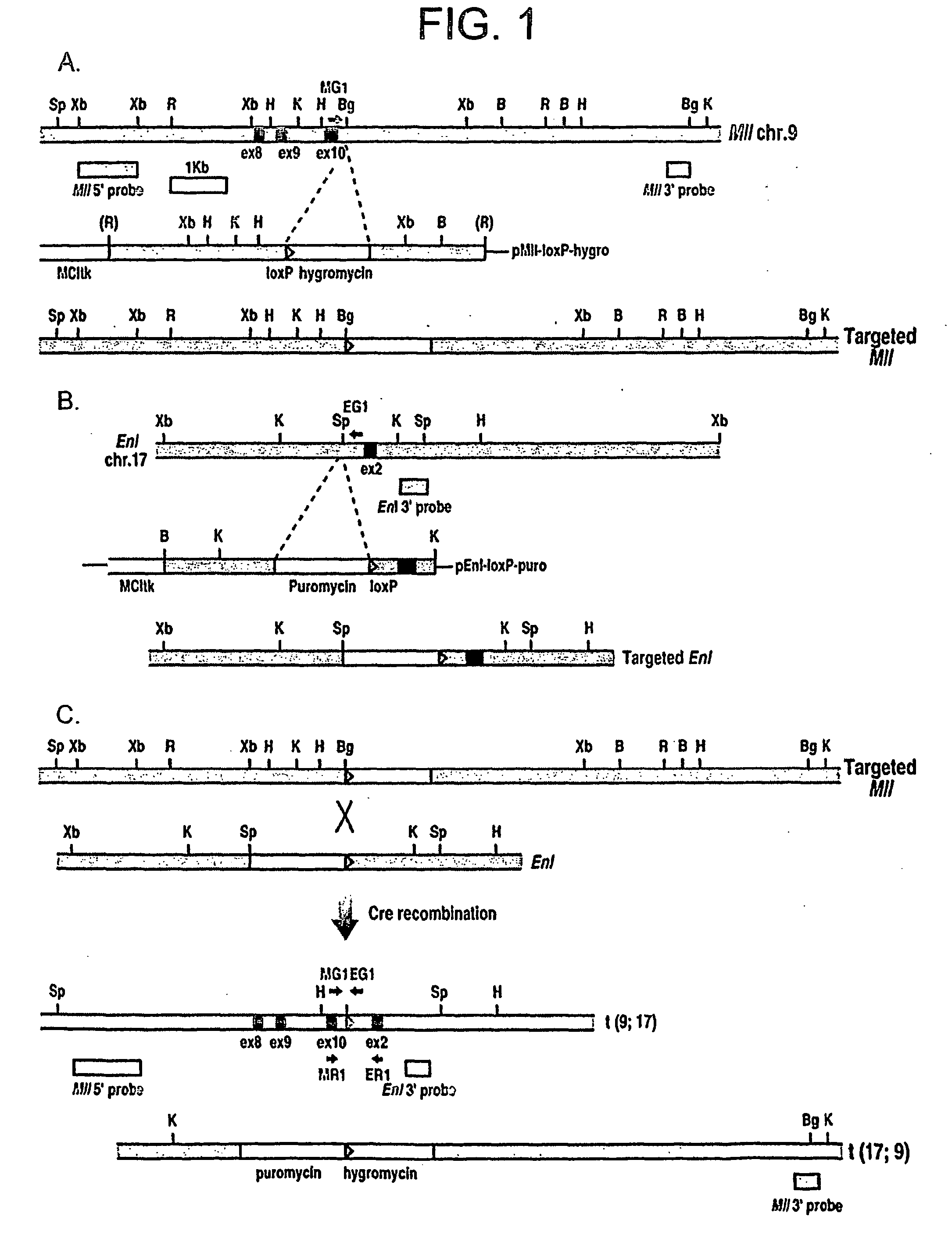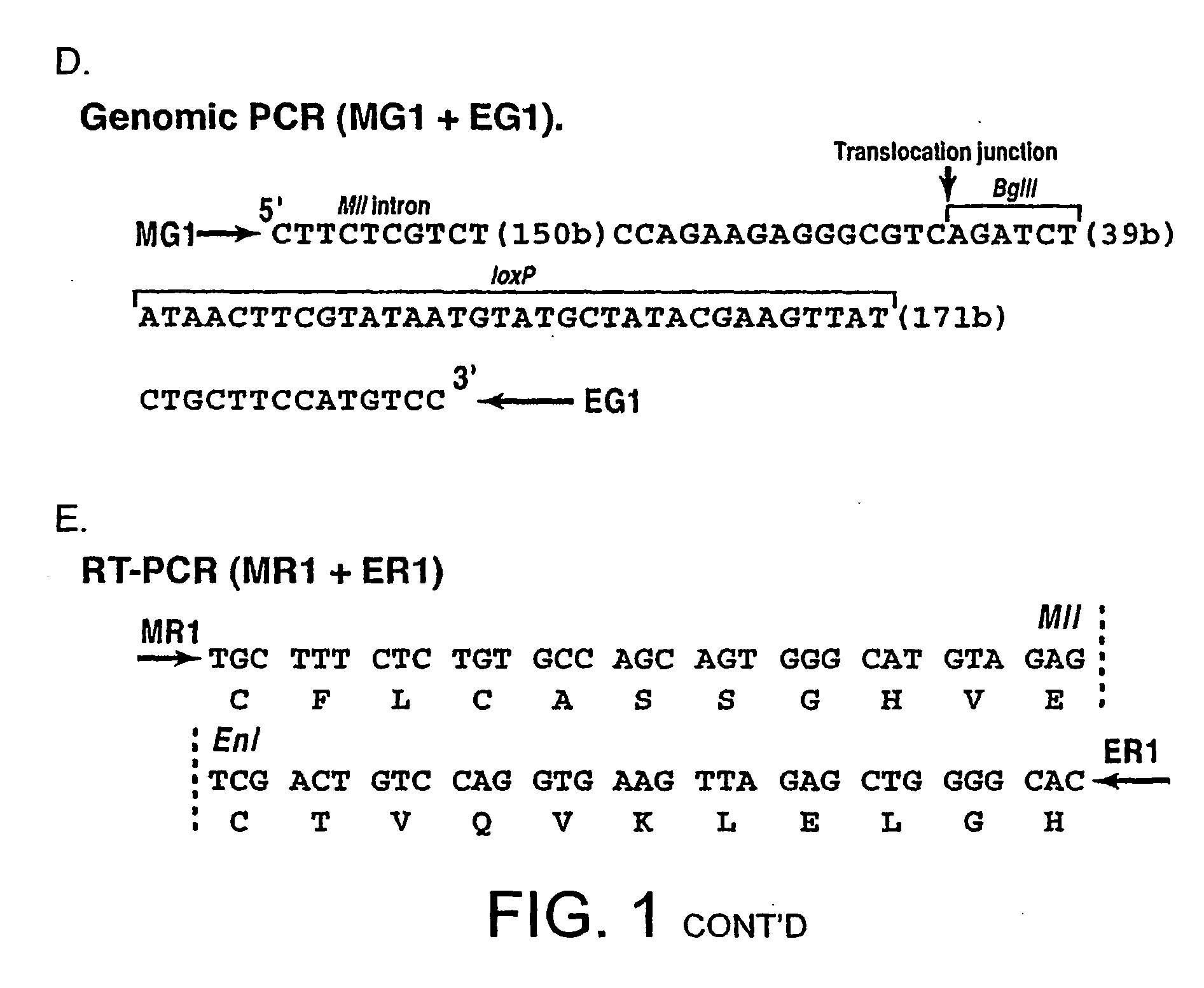Tumor model with chromosomal rearrangement and uses thereof
a chromosomal rearrangement and tumour technology, applied in the field of tumour models, can solve the problem of uncertain whether cre-lox mediated recombination can effectively recreate tumours in experimental animals, and achieve the effect of rapid and reliable results
- Summary
- Abstract
- Description
- Claims
- Application Information
AI Technical Summary
Benefits of technology
Problems solved by technology
Method used
Image
Examples
example 1
Inter-Chromosomal Translocations Between Mouse Mll and Enl Genes
[0465] The strategy used to generate chromosomal translocations was to introduce loxP sites into equivalent introns of the Mll and Enl genes to those involved in human leukaemia translocations, using homologous recombination in ES cells. The ES cells were used to make mice carrying these genetic alterations and inter-bred with Cre-expressing mice. We have previously described the mouse Mll-loxP gene in embryonic stem (ES) cells, at a site corresponding to human translocations (FIG. 1A) (Collins et al., 2000). Similarly, a loxP site was engineered into an Enl gene intron, upstream of exon 2 (FIG. 1B). Somatic recombination between these sites should create a mouse fusion gene equivalent to the MLL-ENL fusion found in human leukaemias with t(11;19) (Ayton and Cleary, 2001).
[0466] Initial tests were performed to confirm that translocations were possible between mouse chromosomes 9 and 17 (Mll and Enl chromosomes respecti...
example 2
Myeloid Leukaemias Develop Carrying t(9;17) in Mice
[0467] The possible tumourigenic effect of the Mll-Enl chromosomal translocation in mice was determined by studying mice in which recombination between the Mll and Enl genes was mediated by Cre recombinase expressed from a knock-in of Cre into the haematopoietic regulator Lmo2 (manuscript in preparation). A cohort of 21 mice was generated carrying the Mll-loxP and Enl-loxP alleles together with the Lmo2-Cre allele. Mice carrying the two loxP alleles and the Cre allele (Mll-loxP; Enl-loxP; Cre) were compared with mice carrying only the loxP alleles (Mll-loxP; Enl-loxP). By 104 days, 98% of the Mll-loxP; Enl-loxP, Cre mice had died or been sacrificed due to ill health, while all Mll-loxP; Enl-loxP mice remained healthy (FIG. 2A; a similar cohort of Lmo2-Cre-only mice also remained disease-free). Post-mortem examination of Mll-loxP; Enl-loxP; Cre mice showed splenomegaly, pale livers, kidneys and bone marrows. Invasion of spleen was o...
PUM
 Login to View More
Login to View More Abstract
Description
Claims
Application Information
 Login to View More
Login to View More - R&D
- Intellectual Property
- Life Sciences
- Materials
- Tech Scout
- Unparalleled Data Quality
- Higher Quality Content
- 60% Fewer Hallucinations
Browse by: Latest US Patents, China's latest patents, Technical Efficacy Thesaurus, Application Domain, Technology Topic, Popular Technical Reports.
© 2025 PatSnap. All rights reserved.Legal|Privacy policy|Modern Slavery Act Transparency Statement|Sitemap|About US| Contact US: help@patsnap.com



